Hedges
I See Electromagnetic Fields!
- Joined
- Mar 28, 2020
- Messages
- 20,531
After watching a video (sorry can’t find it now) showing resistance testing of cheap fuses and name-brand ones, I decided I’d better test the ones I’ve put in our cars.
In the video, it was said that previously Harbor Freight sold fuses, but later recalled them and didn’t carry anymore. Fuses from eBay/Amazon and local auto stores were tested.
As presented in that video, fuses from Littlefuse and Cooper/Bussman meet their specs for resistance. Lower amperage fuses have higher resistance, some about 20 milliohms, so they will heat enough to blow at lower current. The bad fuses were more like 1 milliohm. Also, only a couple different resistance values were found in the entire set.
https://www.lawyersandsettlements.com/lawsuit/fuse-fires.html
http://images.harborfreight.com/cpi/recalls/fuse_sets.html
I looked at Harbor Freight’s website and found they once again have fuses, so I bought a set.
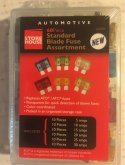
I also have a set of Tool Cache mini fuses for my Honda, which I think I bought at Winchester Auto years ago.
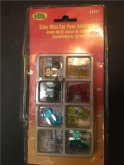
And, another set “Regal” from Leslie’s Pool.

First, I thought I’d do a 4-wire resistance test with my 1 ppm DMM. That should be sensitive enough, right?
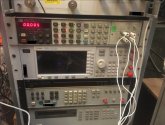
It registered a few milliohm for the 5A fuse, just 1 milliohm in the least significant digit for fuses in the 20 to 30A range.
So what I did next was use my HP 6623A supply (one output has 10A capability) to drive current while measuring voltage 4-wire, and calculated resistance. That’s the bottom instrument in the picture.
With the test programmed to run for 1 second, I ran 5A through each fuse and recorded resistance both initially and after one second. For all brands, the 5A fuse showed measurable resistance increase but larger fuses did not.
With a continuous current, the 5A Harbor Freight fuse got noticeably warm carrying 5A. I increased 1A at a time, and at 8A it popped in one second.
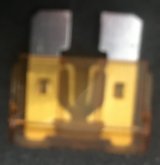
I also tested a 5A Tool Cache mini fuse for 10 seconds at each of 4, 5, 6, 7, 8A. The resistance at end of each test, increased more, of course. At 8A it popped in three seconds.
According to Littlefuse data sheet, at such a 60% overload the fuse should blow between 0.25 seconds and 50 seconds. The time-current curve for 5A show 1 second, exactly what the Harbor Freight fuse did.
Good news is that all of these fuses are really fuses, not just excellent fuse-like objects with the same function as a penny placed under a screw-in fuse (be sure to use a real copper penny, not those cheap zinc ones, which today are also worth more than a penny.)
Not so great news is that every one of the sets had two different fuse values that measured exactly the same resistance. Either 20A & 25A or 25A and 30A. Which just might mean they’re within something like 20% of both values so considered good.
I didn’t have a regulated source for more than 10A, so I only destructively tested 5A samples. But I’m making preparations for testing 100A samples … stay tuned <evil laugh>
In the chart below, note how Harbor Freight and Tool Cache resistance measurements follow the spec from Littlefuse, while Regal has a flatter slope at the low end. For all of them, initial resistance and after 1 second only diverge for 5A (100% load), were identical for larger fuses (50% load and lower)
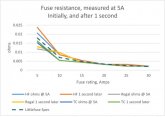
Measured resistance of Tool Cache 5A fuse, 10 seconds at each current:

In conclusion, while counterfeit or fake fuses may be out there, the samples I’ve collected over the years were fine. And Harbor Freight has been taking care of recalls and controlling quality of their products.
In the video, it was said that previously Harbor Freight sold fuses, but later recalled them and didn’t carry anymore. Fuses from eBay/Amazon and local auto stores were tested.
As presented in that video, fuses from Littlefuse and Cooper/Bussman meet their specs for resistance. Lower amperage fuses have higher resistance, some about 20 milliohms, so they will heat enough to blow at lower current. The bad fuses were more like 1 milliohm. Also, only a couple different resistance values were found in the entire set.
https://www.lawyersandsettlements.com/lawsuit/fuse-fires.html
http://images.harborfreight.com/cpi/recalls/fuse_sets.html
I looked at Harbor Freight’s website and found they once again have fuses, so I bought a set.

I also have a set of Tool Cache mini fuses for my Honda, which I think I bought at Winchester Auto years ago.

And, another set “Regal” from Leslie’s Pool.

First, I thought I’d do a 4-wire resistance test with my 1 ppm DMM. That should be sensitive enough, right?

It registered a few milliohm for the 5A fuse, just 1 milliohm in the least significant digit for fuses in the 20 to 30A range.
So what I did next was use my HP 6623A supply (one output has 10A capability) to drive current while measuring voltage 4-wire, and calculated resistance. That’s the bottom instrument in the picture.
With the test programmed to run for 1 second, I ran 5A through each fuse and recorded resistance both initially and after one second. For all brands, the 5A fuse showed measurable resistance increase but larger fuses did not.
With a continuous current, the 5A Harbor Freight fuse got noticeably warm carrying 5A. I increased 1A at a time, and at 8A it popped in one second.

I also tested a 5A Tool Cache mini fuse for 10 seconds at each of 4, 5, 6, 7, 8A. The resistance at end of each test, increased more, of course. At 8A it popped in three seconds.
According to Littlefuse data sheet, at such a 60% overload the fuse should blow between 0.25 seconds and 50 seconds. The time-current curve for 5A show 1 second, exactly what the Harbor Freight fuse did.
Good news is that all of these fuses are really fuses, not just excellent fuse-like objects with the same function as a penny placed under a screw-in fuse (be sure to use a real copper penny, not those cheap zinc ones, which today are also worth more than a penny.)
Not so great news is that every one of the sets had two different fuse values that measured exactly the same resistance. Either 20A & 25A or 25A and 30A. Which just might mean they’re within something like 20% of both values so considered good.
I didn’t have a regulated source for more than 10A, so I only destructively tested 5A samples. But I’m making preparations for testing 100A samples … stay tuned <evil laugh>
In the chart below, note how Harbor Freight and Tool Cache resistance measurements follow the spec from Littlefuse, while Regal has a flatter slope at the low end. For all of them, initial resistance and after 1 second only diverge for 5A (100% load), were identical for larger fuses (50% load and lower)

Measured resistance of Tool Cache 5A fuse, 10 seconds at each current:

In conclusion, while counterfeit or fake fuses may be out there, the samples I’ve collected over the years were fine. And Harbor Freight has been taking care of recalls and controlling quality of their products.


